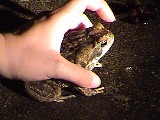 This is a couple of weeks old. See those specks at the bottom of this picture? Those are helicopters. From LiveScience:
This is a couple of weeks old. See those specks at the bottom of this picture? Those are helicopters. From LiveScience:
A cave so huge helicopters can fly into it has just been discovered deep in the hills of a South American jungle paradise.
Researchers found a new species of poison dart frog inside. I don’t have a good feeling about this. Some scientists are starting to suspect that just maybe they are the ones responsible for spreading the fungus that is killing off the frogs of the world.
We humans just can’t seem to resist the urge to discover new things, pick them up, and put them in a specimen jar. If it won’t fit in a jar, we will shoot it with a tranquilizer dart and radio collar it, possibly throwing in a few ear tags for good measure. I can’t think of a worse fate for a biologist than to realize he or she may be solely responsible for the extinction of a life form. There is a possibility this newly discovered frog has just seen its last days. The golden toad of Costa Rica disappeared shortly after its discovery, so did the Kihansi spray toad of Africa.
There was a glimmer of hope last spring:
Breaking update:
In late May 2005, Kihansi Spray Toads were found in the upper wet zone of the Kihansi Gorge. Very few, but some are still clinging on and thus the species is not officially extinct in the wild yet.
Unfortunately, last week’s Science magazine tells us that these rediscovered toads have since disappeared. The fatal frog-killing fungus was not present when the researchers first visited this unique ecosystem … odd that.
Disease brought by ice-age travelers and their dogs may have helped wipe out the megafauna of North and South America. Microbes honed to high levels of lethality by humanity’s intimate contact with domesticated animals regularly swept through Europe and Asia for thousands of years. When the pockmarked and stunted descendants of the survivors of those plagues landed in the Americas they unleashed new plagues on continents full of people without any resistance to them.
Today, researchers are pushing into the last nooks and crannies of our planet and are in all likelihood introducing novel microbes to small, isolated populations without enough genetic diversity to resist new diseases. Maybe it is time for some kind of prime directive before it’s too late.

 This is a couple of weeks old. See those specks at the bottom of this
This is a couple of weeks old. See those specks at the bottom of this 
